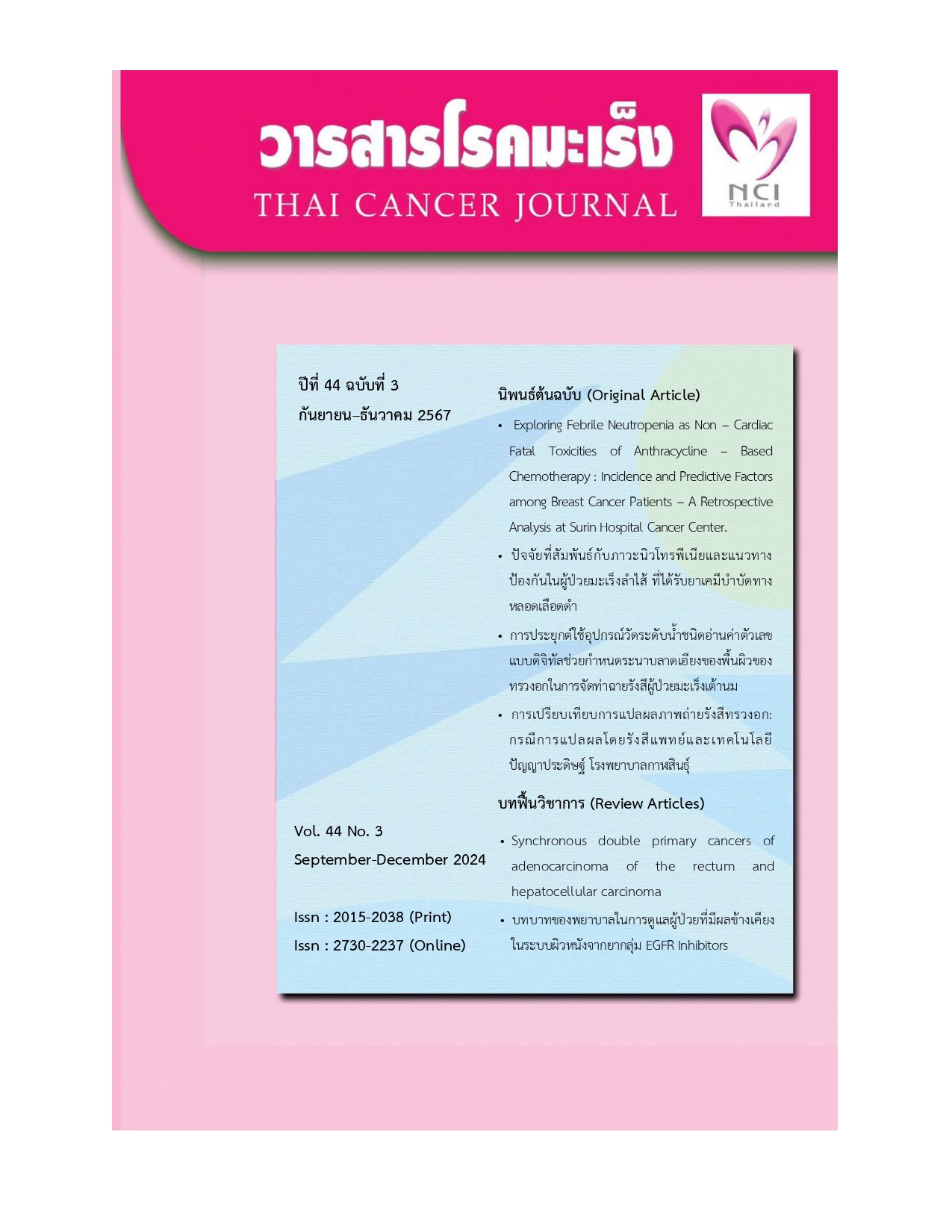การเปรียบเทียบการแปลผลภาพถ่ายรังสีทรวงอก: กรณีการแปลผลโดยรังสีแพทย์และเทคโนโลยีปัญญาประดิษฐ์ โรงพยาบาลกาฬสินธุ์
คำสำคัญ:
การเปรียบเทียบ, เทคโนโลยีปัญญาประดิษฐ์, ภาพถ่ายรังสีทรวงอกบทคัดย่อ
ปัจจุบันปริมาณของภาพถ่ายรังสีทรวงอก (CXR) เพิ่มขึ้นอย่างต่อเนื่อง ส่งผลให้ภาระงานของรังสีแพทย์เพิ่มมากขึ้นจึงได้มีการนำเทคโนโลยีปัญญาประดิษฐ์ (Artificial intelligence: AI) มาช่วยในการแปลผล เพื่อลดขั้นตอนและเพิ่มประสิทธิภาพในการทำงานให้ดีมากขึ้น อย่างไรก็ตามเทคโนโลยี AI อยู่ในระหว่างการพัฒนาอย่างต่อเนื่อง เพื่อให้มีความถูกต้องแม่นยำที่สูงขึ้น การศึกษานี้มีวัตถุประสงค์เพื่อเปรียบเทียบการแปลผลภาพถ่ายรังสีทรวงอกโดยเทคโนโลยี AI และการแปลผลโดยรังสีแพทย์ ทำการศึกษาแบบย้อนหลังเชิงพรรณนา (retrospective descriptive study) กลุ่มตัวอย่างจาก CXR ในโรงพยาบาลกาฬสินธุ์ที่มี AI ในการแปลผลภาพและมีรายงานผลโดยรังสีแพทย์อย่างเป็นทางการ จำนวน 2,207 ภาพ วิเคราะห์เปรียบเทียบความสอดคล้องของการแปลผล การแปลผลภาพถ่ายรังสีทรวงอกโดย AI และโดยรังสีแพทย์ ส่วนใหญ่มีความสอดคล้องกันในระดับที่สูงถึงสูงมาก Kappa เท่ากับ 0.67 ถึง 1.0 และมีค่าความไวและความจำเพาะใกล้เคียงกัน แต่จุดขนาดเล็กในปอด (nodule) และจุดหินปูน (calcified nodule) มีค่าความไวและความสอดคล้องที่ลดลง ส่วนรอยโรคกระดูกหัก (fracture bone) ไม่พบการบ่งชี้จากการแปลผล AI ซึ่งแตกต่างจากการแปลผลโดยรังสีแพทย์ และพบมีความไม่สอดคล้องกันบ้างในบางรอยโรค เช่น รอยโรคในปอดที่ขาวขึ้น หรือจุดขนาดเล็กและบางตำแหน่ง เช่น ชายปอดทั้งสองข้าง ขั้วปอด และซ้อนทับเงาหัวใจ โดยสรุปการแปลผลภาพถ่ายรังสีทรวงอกโดยเทคโนโลยี AI และรังสีแพทย์ มีความสอดคล้องกันสูงถึงสูงมาก แม้ว่าส่วนของรอยโรคกระดูกหัก (fracture bone) ไม่พบการบ่งชี้จากการแปลผลโดย AI ซึ่งแตกต่างจากการแปลผลโดยรังสีแพทย์ การแปลผลโดยเทคโนโลยี AI จะมีความไวต่ำกว่าในจุดขนาดเล็กในปอด หรือจุดหินปูน และบางตำแหน่ง เช่น ขั้วปอด และ ซ้อนทับเงาหัวใจ จะต้องมีความระมัดระวังในการแปลผล อย่างไรก็ตามสามารถนำ AI ไปประยุกต์ใช้ในการแปลผลภาพถ่ายรังสีทรวงอก เพื่อลดขั้นตอนในการทำงานและลดระยะเวลารอคอย
References
Calandriello L, Walsh SLF. Artificial intelligence for thoracic radiology: from research tool to clinical practice. Eur Respir J 2021;57:2100625.
Ridder K, Preuhs A, Mertins A, Joerger C. Routine usage of AI-based chest X-ray reading support in a multi-site medical Supply Center. arXiv 2022.
Wu JT, Wong KCL, Gur Y, Ansari N, Karargyris A, Sharma A, et al. Comparison of chest radiograph interpretations by Artificial Intelligence Algorithm vs Radiology Residents. JAMA Netw Open 2020; 3:e2022779.
Noisiri W, Vijitrsaguan C, Lertrojpanya S, Jiamjit K, Chayjaroon J, Tantibundhit C. Sensitivity and specificity of artificial intelligence for chest diagnostic radiology in lung cancer. J DMS 2021;45:55-61.
Munpolsri P, Sarakarn P, Munpolsri N. Screening of lung cancer using chest radiographs with application AI chest for all (DMS TU) in the context of a Regional Cancer Hospital. J DMS [Internet]. 2021;46:138-44.
Sanklaa K. Evaluation of efficiency of artificial intelligence for chest radiograph interpretation for pulmonary tuberculosis screening in mobile x-ray vehicle. J Assoc Med Sci 2021;54:43-47
Kaviani P, Kalra MK, Digumarthy SR, Gupta RV, Dasegowda G, Jagirdar A, et al. Frequency of missed findings on Chest Radiographs (CXRs) in an international, multicenter study: application of AI to reduce missed findings. Diagnostics (Basel) 2022;12:2382.
Bernstein MH, Atalay MK, Dibble EH, Maxwell AWP, Karam AR, Agarwal S, et al. Can incorrect artificial intelligence (AI) results impact radiologists, and if so, what can we do about it? A multi-reader pilot study of lung cancer detection with chest radiography. Eur Radiol 2023;33:8263-9.
Sicular S, Alpaslan M, Ortega FA, Keathley N, Venkatesh S, Jones RM, et al. Reevaluation of missed lung cancer with artificial intelligence. Respir Med Case Rep 2022;39:101733.
Osatavanichvong K, Nakano E de G, Dessí G, Saksirinukul T. Evaluation Artificial Intelligent (AI) assists radiologist in radiographic chest interpretation. BKK Med J 2019;14:59-65.
Harris M, Qi A, Jeagal L, Torabi N, Menzies D, Korobitsyn A, et al. A systematic review of the diagnostic accuracy of artificial intelligence-based computer programs to analyze chest x-rays for pulmonary tuberculosis. PLoS One 2019;14:e0221339.
Shin HJ, Han K, Ryu L, Kim EK. The impact of artificial intelligence on the reading times of radiologists for chest radiographs. NPJ Digit Med 2023;6:82
Downloads
เผยแพร่แล้ว
ฉบับ
บท
License

This work is licensed under a Creative Commons Attribution-NonCommercial-NoDerivatives 4.0 International License.
บทความทีตีพิมพ์ในวารสารโรคมะเร็งนี้ถือว่าเป็นลิขสิทธิ์ของมูลนิธิสถาบันมะเร็งแห่งชาติ และผลงานวิชาการหรือวิจัยของคณะผู้เขียน ไม่ใช่ความคิดเห็นของบรรณาธิการหรือผู้จัดทํา






